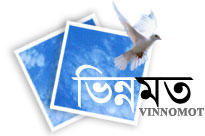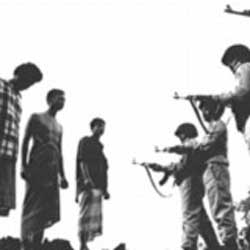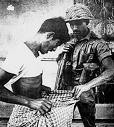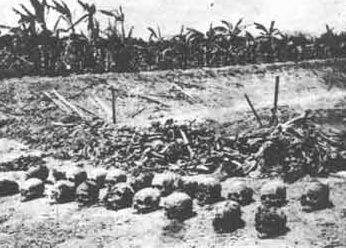NEWS Bulletin from Indian Society For Sustainable Agriculture And Rural Development
------------------------------------
1. Govt planning autonomous body to regulate GM crop development
2. Indo-Thai gem & jewellery trade can be complimentary, says study
3. Agri Export Zones (AEZs) prove much better than Special Export Zones (SEZs) - AEZ exports cross Rs 10,000 cr, zeroing in on target
4. Rural India lags in land records computerisation
------------------------------------
Govt planning autonomous body to regulate GM crop development
ASHOK B SHARMA
Posted online: Monday , June 02, 2008 at 2201 hrs IST
New Delhi, Jun 1 The government is planning to set up a new autonomous body to regulate the development and release of genetically modified (GM) crops, livestock and fishes, and food, as well as recombinant pharma and industrial products. The department of biotechnology (DBT) has already drafted the National Biotechnology Regulatory Bill-2008 for setting up of the proposed National Biotechnology Regulatory Authority (NBRA).
Though the proposed NBRA would be autonomous, it would attached to DBT in the same lines as the autonomous Food Safety and Standards Authority (FSSA) is attached to the Union health ministry.
Though the FSSA is empowered by law to regulate GM foods, the DBT proposal said, "from an operational standpoint, there are opportunities to coordinate the safety assessment of GM foods between FSSA and the NBRA." It suggested that the risk assessment unit of NBRA can undertake risk assessment on behalf of FSSA and submit its report to its chairperson for approval. Alternatively, GM food safety assessment can remain exclusively under FSSA and the regulation of GM foods be vested with NBRA.
The public sector, Biotech Consortium India Ltd is slated to conduct a series of public consultations on the Bill and the proposed authority.
It is proposed that NBRA will be headed by a chairperson and consists of chief regulatory officers, regulatory branches for different products, a risk assessment unit, and cross-sectoral offices for national and international policy coordination, legal affairs, economic analysis, and capacity building. The NBRA chairperson will be assisted an inter-ministerial advisory body and a national biotechnology advisory body. But these two bodies will not interfere in the product specific decisions taken by NBRA.
The draft bill has deviated from the suggestions of Swaminathan and Mashelkar panels, which had said that the proposed NBRA should have separate wings for GM crops, GM livestock and fisheries, and recombinant pharma and industrial products. It has, however, suggested setting up of the National Biotechnology Regulatory Appellate Tribunal.
----------------------------------------
Indo-Thai gem & jewellery trade can be complimentary, says study
ASHOK B SHARMA
Posted online: Monday , June 02, 2008 at 2239 hrs IST
New Delhi, Jun 1 A study jointly conducted by the apex industry body, Ficci and PriceWaterhouse Coopers has said that trade in gems and jewellery between India and Thailand can be of a complimentary nature. Thailand has a rich deposit of quality gemstones, which can be sourced by India. India is a major exporter of cut diamonds.
Both, India and Thailand are members of BIMST-EC and gems and jewellery is one of the most dynamic export-oriented sector in the region. However, the present level of trade is below its potential. In 2005-06 India's export of gems and jewellery to Thailand was $ 333.46 million, out of which of polished diamonds was $ 285.58 million.
The study also said that bilateral trade between the two countries has boosted the trade in auto components and Indian auto majors like Tata Motors have invested in Thailand. They argue that the synergies existing between the two countries should be encashed for boosting trade and investment for a win-win situation, particularly for development of infrastructure in India's northeastern states. Northeast India can be well connected with the neighbouring countries in South-East Asian region.
The study suggested cooperation in infrastructure, entertainment and media industry, hospitality and the wellness industry. It makes out a case for reviving th future harvest scheme between the two countries, which can lead to an effective FTA.
--------------------------------------
Agri Export Zones (AEZs) prove much better than Special Export Zones (SEZs)
AEZ exports cross Rs 10,000 cr, zeroing in on target
ASHOK B SHARMA
Posted online: Monday , June 02, 2008 at 2333 hrs IST
New Delhi, Jun 1 Agri export zones (AEZs), with comparatively lower level of investment than the special economic zones (SEZs), have the potential to boost exports. A recent study of 60 AEZs spread across 20 states conducted by Agriculture and Processed Foods Export Development Authority (APEDA) shows AEZs are approaching the cumulative export target.
According to the report by APEDA, AEZs have recorded cumulative exports of Rs10,685.29 crore up to February 2008 against the target Rs 11,821.47 crore. The investments by the central and state government agencies and by the private sector in the AEZs have not been up to the mark. Against a projection of Rs 1,717.95 crore, the cumulative investment so far has been Rs 1,097.53 crore.
AEZs have been less controversial than SEZs because they have not resulted in a change of land use for industrial and other activities. AEZs are not fixed by physical boundaries like SEZs-they are regions in different states known for growing special crops like gherkins, grapes, special varieties of mango, lichi, potato, pineapples, Darjeeling tea, rose onion, vanilla, flowers, basmati rice, medicinal and aromatic plants, pomegranate, banana, walnut, garlic, spices, duram wheat, lentils & gram, cashew nut, honey, apple, ginger, turmeric, coriander and cumin.
Over the years there have been sporadic efforts at setting up AEZs, with the state governments clamouring for approvals. This had resulted in the setting up of as many as 60 AEZs in 20 states. In most cases the state and central governments have not lived up to their commitments of ensuring adequate infrastructure, and the investment from the private sector has not been to the desired level. The APEDA review, therefore, said, "A package needs to be developed to suggest solutions to these problems and agencies identified to implement these in a given time-frame."
Andhra Pradesh with five AEZs has a record export turnover of Rs 2,852.59 crore. The AEZ for mango pulp and fresh vegetables in Chittoor district alone recorded an export turnover of Rs 2,736.03 crore, while export of mango and grapes in Ranga Reddy, Medak and Mehaboobnagar districts earned Rs 18.29 crore.
The mango AEZ in Krishna district is expected to record an export of Rs 2.75 crore and the gherkins AEZ in Mehaboobnagar, Ranga Reddy, Medak, Karimnagar, Warangal, Ananthapur and Nalgonda districts is likely to bring in Rs 44.5 crore through exports. The chilli AEZ in Guntur district earned Rs 51 crore in exports.
Next to Andhra Pradesh, in performance, is Kerala with two AEZs. Its horticulture products AEZ in Thirssur, Ernakulam, Kottayam, Alappuzha, Pathanamthitta, Kollam, Thiruvananthapuram, Idukki and Palakkad districts is expected to earn through Rs 2,277.79 crore. Kerala's medicinal plant AEZ is yet to become operational.
Karnataka's AEZs could bring in Rs 1544.79 crore hrough exports. Its gherkins AEZ located in Tumkur, Bangalore, Hassan, Kolar, Chiradurga, Dharwad and Bagalkot districts registered an export of Rs 1,237.05 crore.
The rose onion AEZ in Bangalore and Kolar districts earned an export amounting to Rs 276 crore, while its floriculture AEZ in Bangalore, Kolar, Tumkur, Kodagu and Belgaum districts earned Rs 31.74 crore.
The vanilla AEZ in Karanataka is yet to become operational.
The success story of AEZs is not just limited to south India. In north India, Punjab with its three AEZs has already earned Rs 1,523.83 crore through exports. The basmati rice AEZ located in Gurudaspur, Amritsar, Kapurthala, Jalandhar, Hoshiarpur and Nawanshashar districts fetched Rs 1,521 in exports. Export earnings from Punjab's vegetable and potato AEZs have been negligible.
Maharashtra is the fifth state, which has done well in earnings from exports through AEZs. The state has eight AEZs for grapes and grapewine, alphonso mango, kesar mango, floriculture, onions, pomegranate, banana and oranges.
The cumulative export earning from these eight AEZs are Rs 1,166.34 crore.
There are several such success stories in other AEZs spread across other states. The APEDA review also noted that some AEZs are yet to become operational, like the Darjeeling tea AEZ in West Bengal, vanilla AEZ in Karnataka, lentils & gram AEZs in Madhya Pradesh, sesame seed AEZ in Gujarat and medicinal plant AEZ in Kerala....
------------------------------------------
Rural India lags in land records computerisation
ASHOK B SHARMA
Posted online: Monday , June 02, 2008 at 2034 hrs IST
New Delhi, Jun 1 The government scheme of computerisation of land records, on since 1988-89, has not proceeded with the desired pace. The main objective of the scheme was to provide landowners with computerised copies of ownership, crop and tenancy and updated copies of records of rights (RoRs) on demand.
According to the recent records maintained by the Union ministry for rural development only 13 states out of 35 states and Union territories are in a position to provide RoRs on demand. These states are Andhra Pradesh, Chhattisgarh, Goa, Gujarat, Karnataka, Madhya Pradesh, Maharashtra, Rajasthan, Tamil Nadu, Sikkim, Uttar Pradesh, Uttarakhand and West Bengal.
The scheme of computerisation of land records (CLR) was extended to cover 4,423 talukas or tehsils (revenue circles) in 1021 sub-division in 582 districts of the country. Computer centres have been set up in 3,356 tehsils and in only 2902 tehsils computerised copies of RoRs are being issued to landowners on demand.
The scheme is fully funded by the central government for completing data entry, setting up of computer centres at tehsil level, block, circle sub-divisional and district levels a also for setting up of a monitoring cell at the state level. Funds are also provided for imparting training and application of software. Digitisation of maps has also been allowed under the scheme. Till January 31, 2008 the central government released Rs 561.30 crore to state governments, out of which only Rs 348.40 crore was utilised, meaning 62% utilization of funds. In the current year, the central government released Rs 15.95 crore to state governments.
The importance of computerization of land records in rural areas cannot be over emphasized, particularly in this IT age and where India is an IT leader. But unfortunately rural India is lagging far behind in e-governance.
There is another centrally sponsored scheme called Strengthening of Revenue Administration and Updating of Land Records (SRA&ULR), launched since 1987-88 on 50:50 contribution basis between the Centre and the states.
The main objective of the scheme is for strengthening of survey and settlement organizations for which financial assistance is provided for purchase of modern survey equipment like GPS, EDM, total stations, theodolites, work stations, aerial survey office, photocopiers, laminating machines. Since the inception of SRA&ULR, Centre has provided Rs 417.20 crore to state governments, out of which only Rs 283.13 crore was utilized, implying 68% utilisation of funds.
It has been proposed to merge these two scheme—CLR and SRA&ULR—into a new scheme called National Land Records Modernisation Programme (NLRMP). This revamp scheme would generate three layers of data namely spatial data from satellite imagery or aerial photography, topographic maps and other data from the Survey of India and Forest Survey of India and land record data and maps will be integrated and harmonised on geographic information system platform.
The primary focus of this revamped programmed will be to provide RoRs with maps to scale, other land-based certificates like caste certificate, income certificate, domicile certificate, land passbook, and eligibility criteria of the holder for getting benefits under government's welfare schemes....
--------------------------------------
Messenger blocked? Want to chat?
Here is the solution. 



 Younger men and adolescent boys, of whatever social class, were equally targets. According to Rounaq Jahan, "All through the liberation war, able-bodied young men were suspected of being actual or potential freedom fighters. Thousands were arrested, tortured, and killed. Eventually cities and towns became bereft of young males who either took refuge in India or joined the liberation war." Especially "during the first phase" of the genocide, he writes, "young able-bodied males were the victims of indiscriminate killings." ("Genocide in Bangladesh," in Totten et al., Century of Genocide, p. 298.) R.J. Rummel likewise writes that "the Pakistan army [sought] out those especially likely to join the resistance — young boys. Sweeps were conducted of young men who were never seen again. Bodies of youths would be found in fields, floating down rivers, or near army camps. As can be imagined, this terrorized all young men and their families within reach of the army. Most between the ages of fifteen and twenty-five began to flee from one village to another and toward India. Many of those reluctant to leave their homes were forced to flee by mothers and sisters concerned for their safety." (Death By Government, p. 329.) Rummel describes (p. 323) a chilling gendercidal ritual, reminiscent of Nazi procedure towards
Younger men and adolescent boys, of whatever social class, were equally targets. According to Rounaq Jahan, "All through the liberation war, able-bodied young men were suspected of being actual or potential freedom fighters. Thousands were arrested, tortured, and killed. Eventually cities and towns became bereft of young males who either took refuge in India or joined the liberation war." Especially "during the first phase" of the genocide, he writes, "young able-bodied males were the victims of indiscriminate killings." ("Genocide in Bangladesh," in Totten et al., Century of Genocide, p. 298.) R.J. Rummel likewise writes that "the Pakistan army [sought] out those especially likely to join the resistance — young boys. Sweeps were conducted of young men who were never seen again. Bodies of youths would be found in fields, floating down rivers, or near army camps. As can be imagined, this terrorized all young men and their families within reach of the army. Most between the ages of fifteen and twenty-five began to flee from one village to another and toward India. Many of those reluctant to leave their homes were forced to flee by mothers and sisters concerned for their safety." (Death By Government, p. 329.) Rummel describes (p. 323) a chilling gendercidal ritual, reminiscent of Nazi procedure towards  In the dead region surrounding Dacca, the military authorities conducted experiments in mass extermination in places unlikely to be seen by journalists. At Hariharpara, a once thriving village on the banks of the Buriganga River near Dacca, they found the three elements necessary for killing people in large numbers: a prison in which to hold the victims, a place for executing the prisoners, and a method for disposing of the bodies. The prison was a large riverside warehouse, or godown, belonging to the Pakistan National Oil Company, the place of execution was the river edge, or the shallows near the shore, and the bodies were disposed of by the simple means of permitting them to float downstream. The killing took place night after night. Usually the prisoners were roped together and made to wade out into the river. They were in batches of six or eight, and in the light of a powerful electric arc lamp, they were easy targets, black against the silvery water. The executioners stood on the pier, shooting down at the compact bunches of prisoners wading in the water. There were screams in the hot night air, and then silence. The prisoners fell on their sides and their bodies lapped against the shore. Then a new bunch of prisoners was brought out, and the process was repeated. In the morning the village boatmen hauled the bodies into midstream and the ropes binding the bodies were cut so that each body drifted separately downstream. (Payne, Massacre [Macmillan, 1973], p. 55.)
In the dead region surrounding Dacca, the military authorities conducted experiments in mass extermination in places unlikely to be seen by journalists. At Hariharpara, a once thriving village on the banks of the Buriganga River near Dacca, they found the three elements necessary for killing people in large numbers: a prison in which to hold the victims, a place for executing the prisoners, and a method for disposing of the bodies. The prison was a large riverside warehouse, or godown, belonging to the Pakistan National Oil Company, the place of execution was the river edge, or the shallows near the shore, and the bodies were disposed of by the simple means of permitting them to float downstream. The killing took place night after night. Usually the prisoners were roped together and made to wade out into the river. They were in batches of six or eight, and in the light of a powerful electric arc lamp, they were easy targets, black against the silvery water. The executioners stood on the pier, shooting down at the compact bunches of prisoners wading in the water. There were screams in the hot night air, and then silence. The prisoners fell on their sides and their bodies lapped against the shore. Then a new bunch of prisoners was brought out, and the process was repeated. In the morning the village boatmen hauled the bodies into midstream and the ropes binding the bodies were cut so that each body drifted separately downstream. (Payne, Massacre [Macmillan, 1973], p. 55.)
















